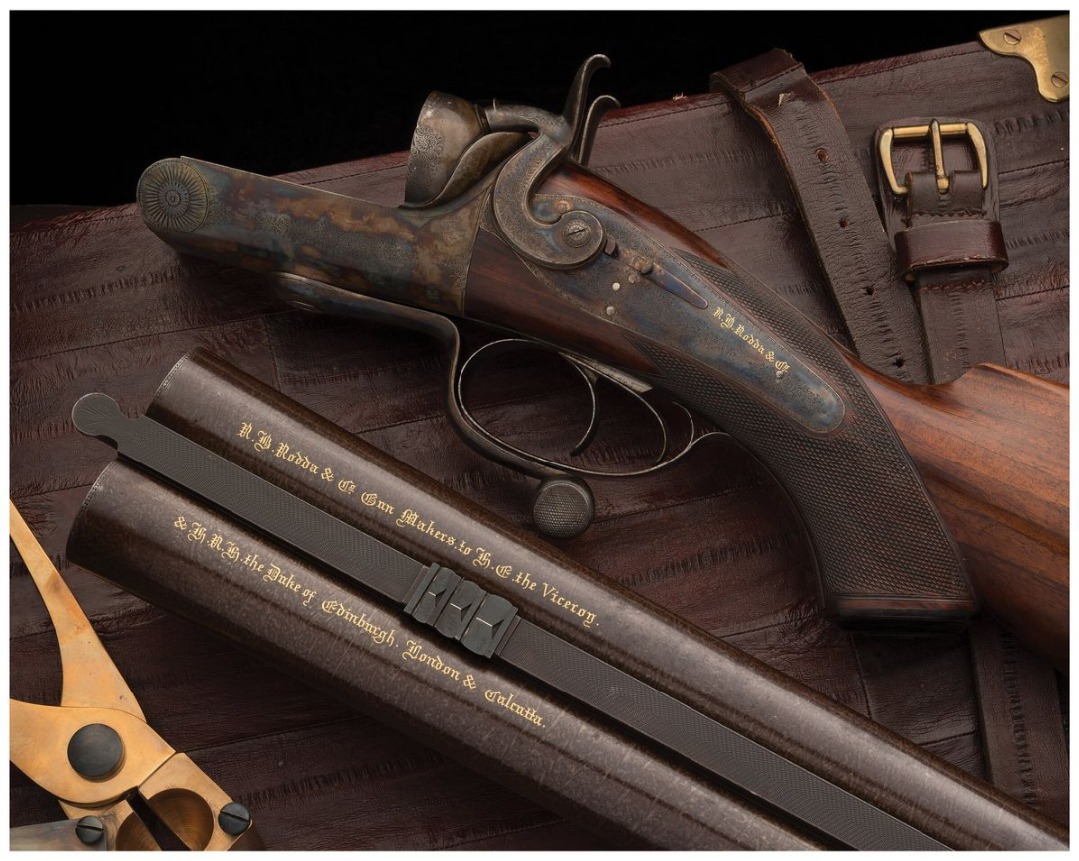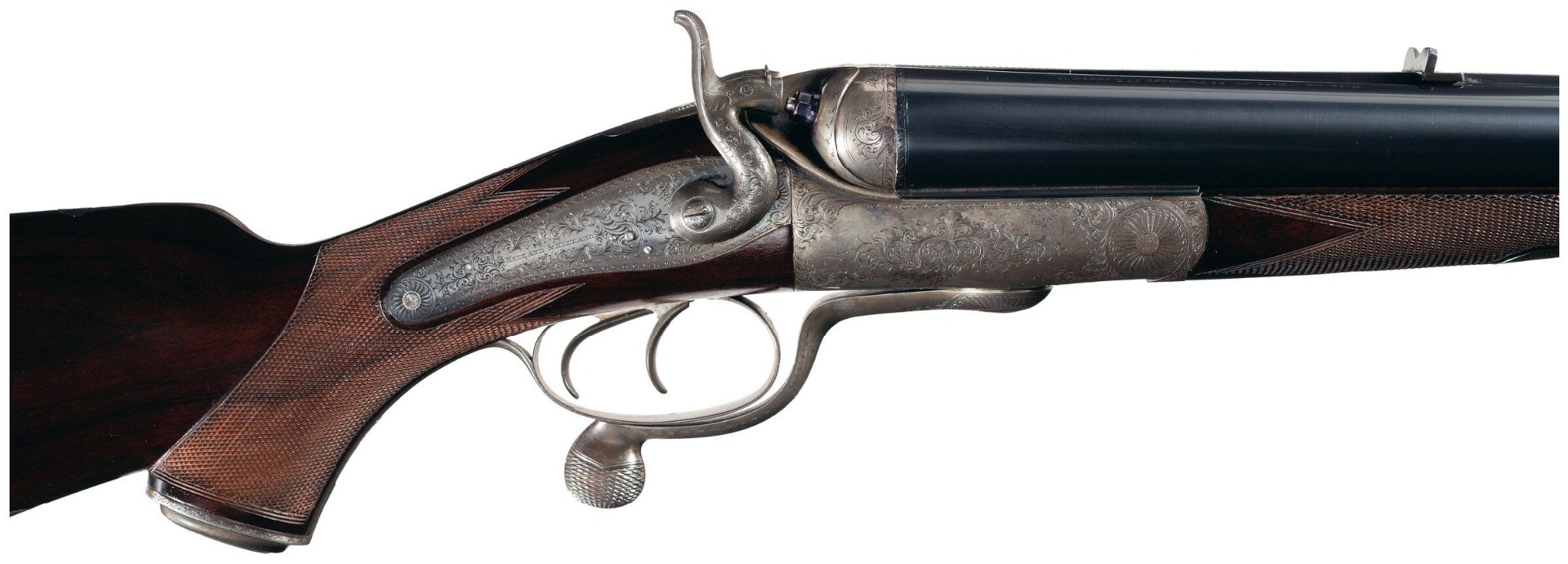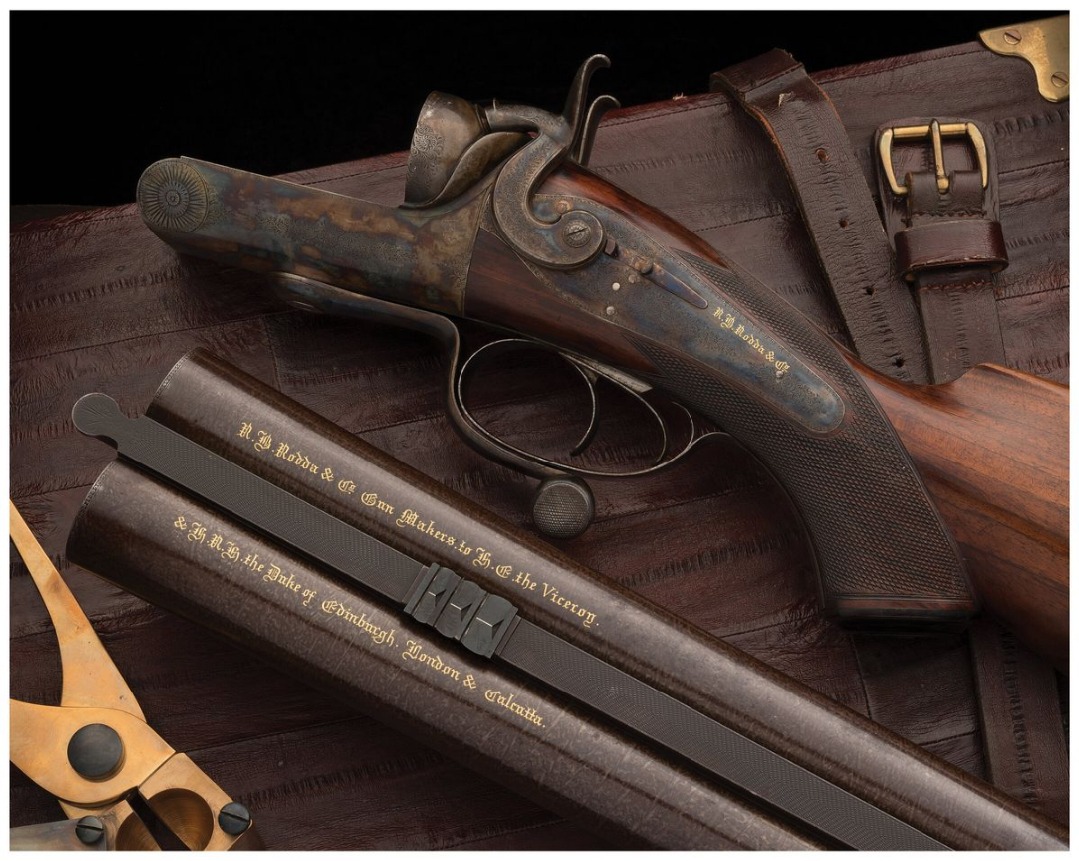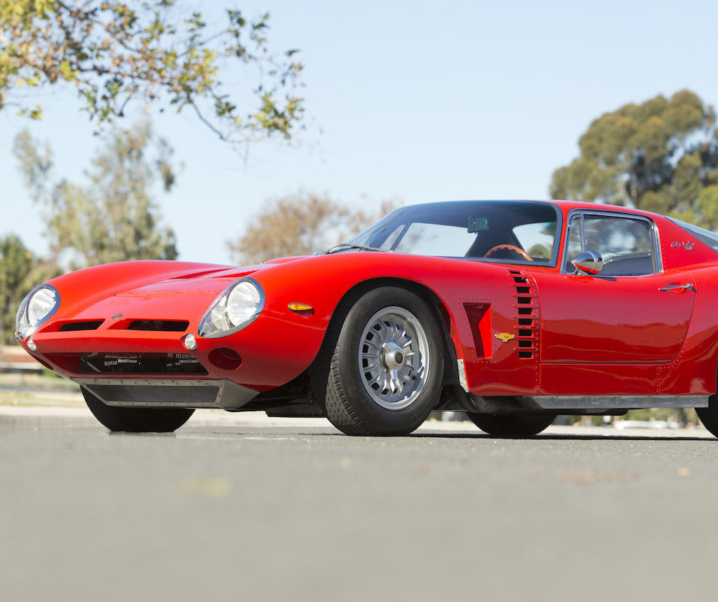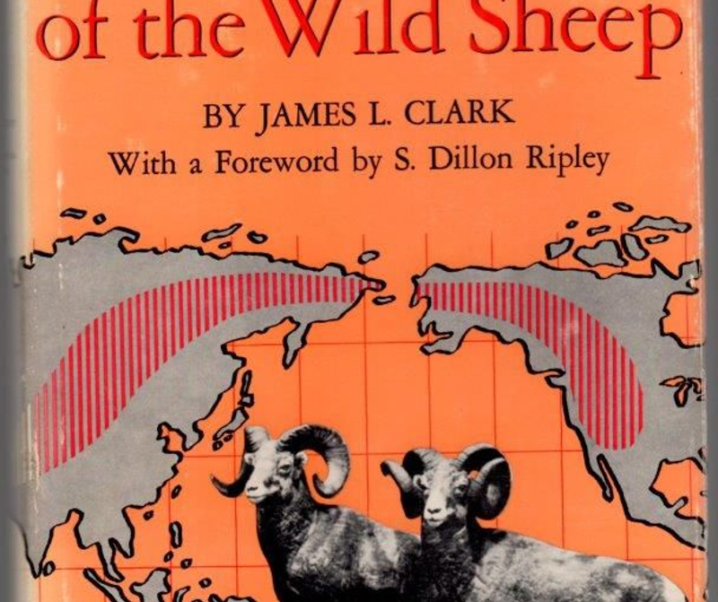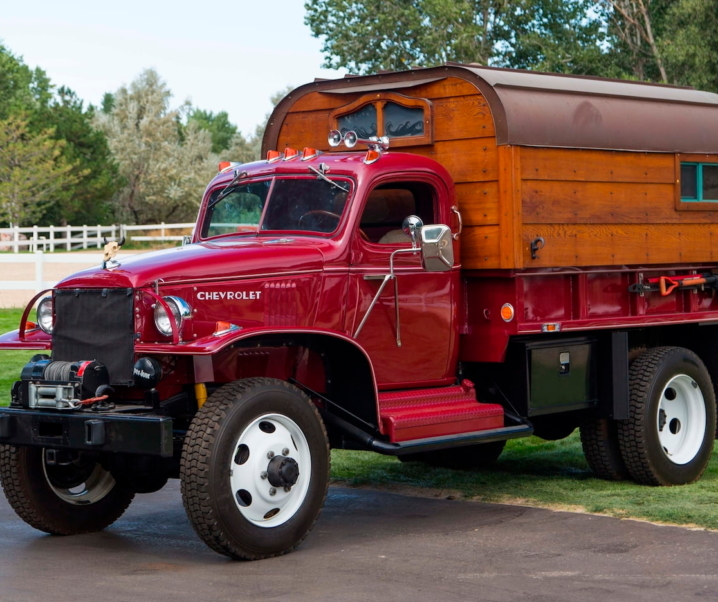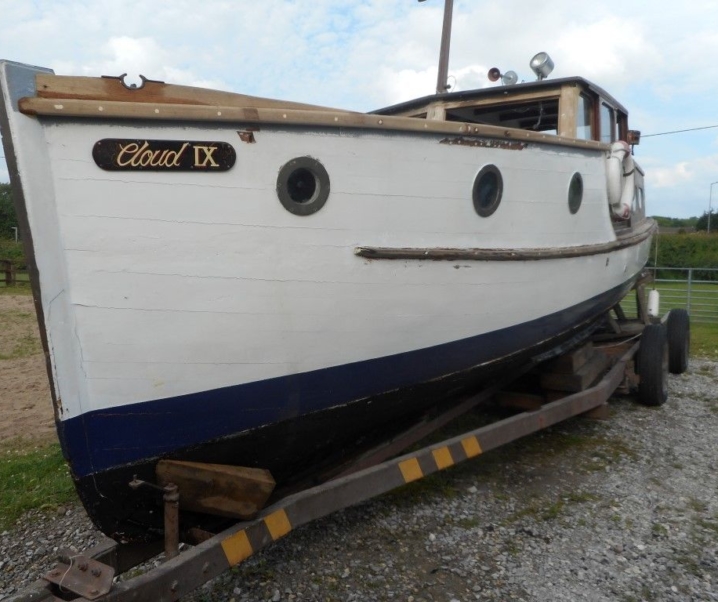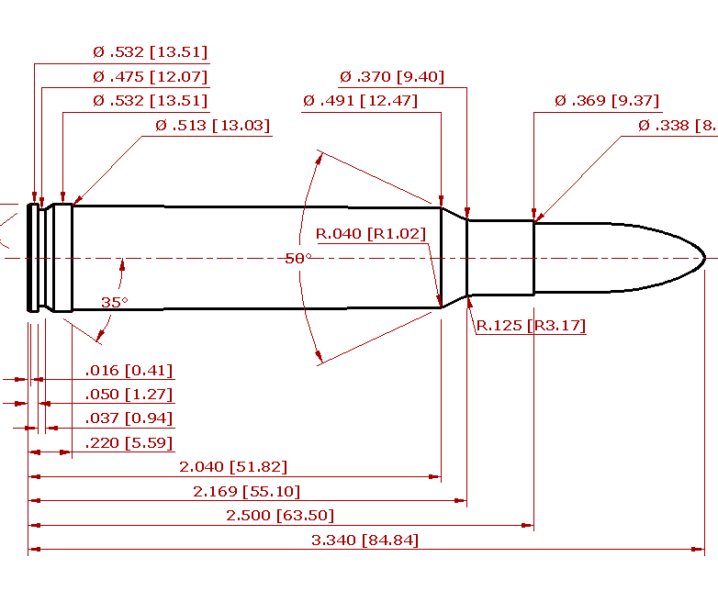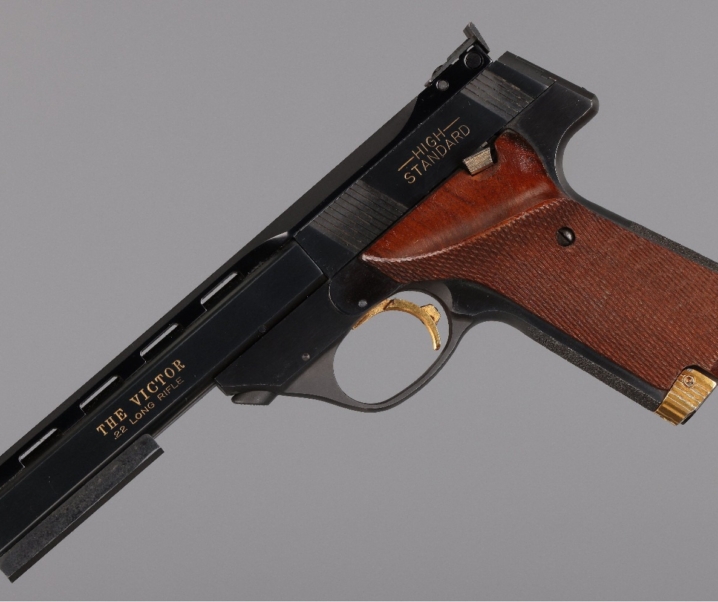Fast Facts
- Large bore guns were developed during the eighteenth and nineteenth centuries for water-fowling. These were commonly of 8 bore, 6 bore and 4 bore, sizes usable for firing from the shoulder, and even larger bores for use as punt guns.
- As British and European settlers became established in the African and Asian colonies they encountered large and dangerous game such as elephants, rhinoceros, hippo, crocodiles and big cats. To deal with these threats to life and property there was a need for large 8, 6, 4 and even 2 bore guns loaded with ball projectiles. So gun makers adapted their large water-fowling guns for big and dangerous game.
- For Africa and elsewhere the 8 bore rifle with 22-24″ barrels became the largest practical rifle for the hunter to carry and use.
- The 4 bore were generally considered too heavy for hunting on foot, although some African ivory hunters used them, but had them carried by a gun bearer until they needed to be used. These were useful for hunting from a howdah mounted on the back of an elephant in India and Asia, and for static hunting where the shooter waits for the game to be driven to him/her by a team of beaters, as would be the case for Indian rulers and their guests for example.
- Because of the very heavy recoil exacerbated by the torsional effect on firing 4 bore rifles are less common than 4 bore smoothbore guns.
- 8 bore shotguns were often used for crocodile.
Dangerous Game Guns and Rifles in the Black Powder Era
The early days of the European colonies in Southern Africa begin with the 1652 Dutch East India Company (VOC = Verenigde Oostindische Compagnie). These early settlers’ firearms were limited to muzzleloading matchlocks and the Dutch quickly found that these were no match for the large and dangerous animals that had little fear of human beings. The settlers even resorted to bringing ship’s cannon onto land mounted on a wagon with which to deal with problem elephant, buffalo, hippo and lion.
Firearms development continued into the 1700’s by which time the British arrived to take over the colony in 1795, during the Napoleonic Wars.
These events helped open up southern Africa to explorers who financed their explorations by ivory hunting. But such activities were only made possible as firearms development reached the point of portability and practical usability to make elephant hunting possible (without the need for a ship’s cannon mounted on a cart).
Sir Samuel Baker who began exploration in Southern Africa in 1861 used a 6 bore muzzleloading rifle that weighed 21 lb and sported no less than a yard long barrel. His method of hunting elephant was to ride up to the animal on his horse and try to shoot the creature in the brain – and then beat a hasty retreat to a safe distance to wait and make sure the pachyderm was in fact dead.

As time went on British gunsmiths – W.W. Greener being one of the most influential – managed to create heavy calibre practical breechloading guns and rifles, in consultation with the men who were using these arms against dangerous game in Africa and Asia.
Greener’s book “The Gun and its Development” is highly recommended: it is a veritable gold mine of information.
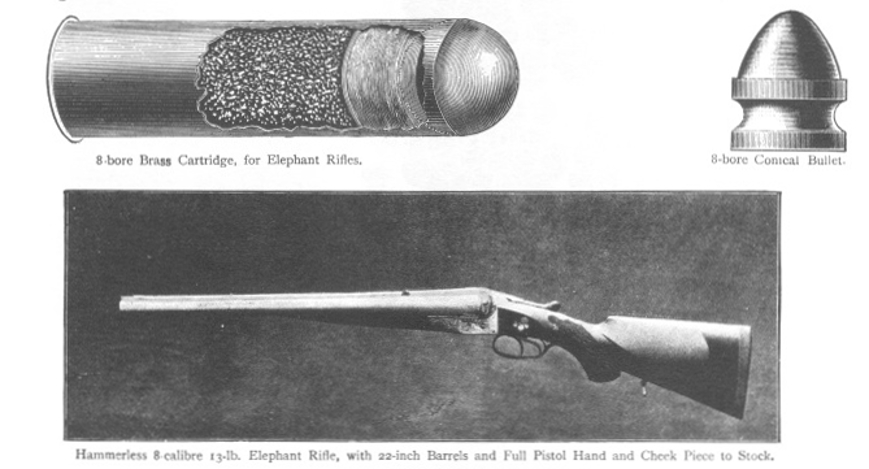
Greener favoured the 8 bore as being the largest calibre gun that could be carried and used in the field by a fit sportsman. His 8 bores typically had 22 inch barrels and weighed around 13-14 lb, which is slightly lighter than was used in the later nitro era .600 Nitro Express. These guns could be smooth bore or rifled: rifled 8 bores producing more recoil than smooth bores.

Despite their large size and heavy recoil, these 8 bore guns did not produce great penetration, certainly not as much as the nitro rifles that ultimately replaced them such as the 450, 470 and .500 Nitro Expresses for example. So there were hunters who wanted more “knock-down” power and for them the 4 bore guns were the biggest practical ones available.
8 bore rifles produced recoil that can best be described as “rather uncomfortable” to use British understatement, and they had a bore size large enough to produce a twisting effect on the rifle as the bullet engaged the rifling and was given its turning motion – a case of Newton’s Third Law of Motion “Every action produces an equal and opposite reaction” being put into effect. So Greener took the trouble to make 8 bore rifles for a right handed shooter with a right hand twist, and for a left handed shooter left hand twist, in order to some extent ameliorate the torsion effect on recoil.
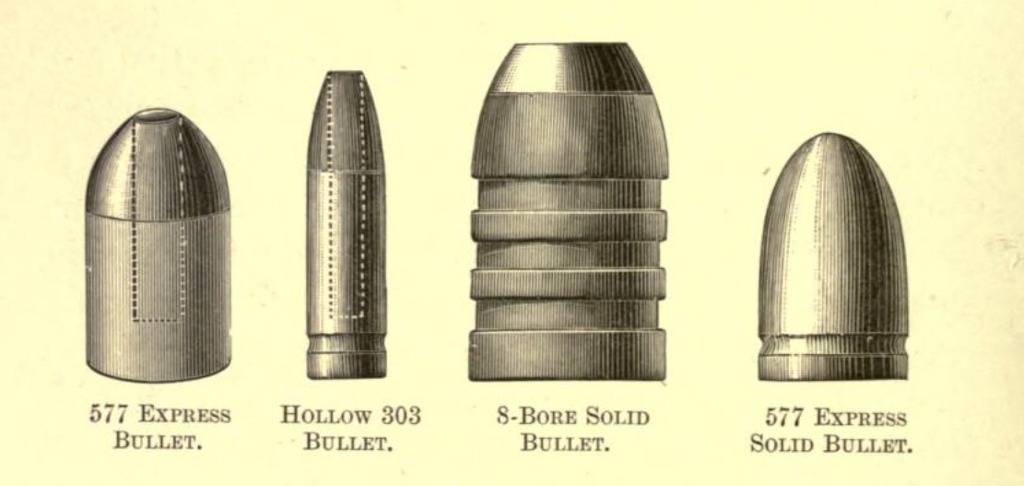
One of the most famous users of the 4 bore was British Ivory Hunter and explorer Frederick Courtenay Selous who owned three of them for a while. He stated later in life that the recoil of his 4 bores caused him permanent nerve damage. Selous was finally able to get rid of his 4 bores and he ultimately replaced them with a .425 Westley Richards which was vastly easier to shoot accurately, and which killed elephant with much better efficiency, it being perfectly capable of penetrating to an African elephant’s brain even in a frontal shot.
The 4 bore seems to have been more popular in India and Asia where hunting was often undertaken from a howdah mounted on the back of an elephant. The quarry was elephant, tiger, gaur, and rhino.
Below we have a couple of examples of a typical 8 bore and a 4 bore rifle from this era.
Holland and Holland 8 Bore Double Rifle

This 1891 8 bore rifle is a good example of a typical 8 bore rifle of the late nineteenth century. It was made by London maker Holland and Holland: one of the most famous gunmakers in Britain, and is sensibly equipped with a broad “Open Vee” rear sight graduated for 50 yards, which would be the maximum range one would expect to engage a dangerous animal.
This rifle is fitted with 24″ barrels, and has a bead foresight with a flip up “Moon Sight” for use in dull light.
The rifle has a 14½” length of pull and weights 16lb 1½oz, making it of similar weight to a 600 Nitro Express. It has rebounding back action locks and the front trigger is sprung to protect the shooters finger under recoil.

Large bore rifles by Britains “best gun” makers, such as Holland & Holland, handle surprisingly well. They tend to feel a tad lighter than they actually are and for an owner for whom the gun was fitted will come to the shoulder instinctively.

Every aspect of the rifle, such as the length of pull, angle of the butt-stock, drop at comb, and cheek-piece, are all designed to ensure shooting comfort – despite the power of the 8 bore cartridge that will be fired.
This rifle is coming up for sale by Rock Island Auction at their Premier Firearms Auction to be held between August 26th-28th, 2022.
To find out more you can visit the listing here.
R.B. Rodda 4 Bore Double Rifle

R.B. Rodda of London and Calcutta were a retailer of some of the finest products of the British gun trade. Rodda did not actually make guns but had them custom made by some of the most respected gunsmiths in Britain. Their primary market was British colonial India and to the other nations in that proximity.

The normal customers for R.B. Rodda guns were colonial officials and businessmen, and rulers of local states and their senior staff. Rodda guns were “best quality”, and their reputation depended on the consistent quality of their products.
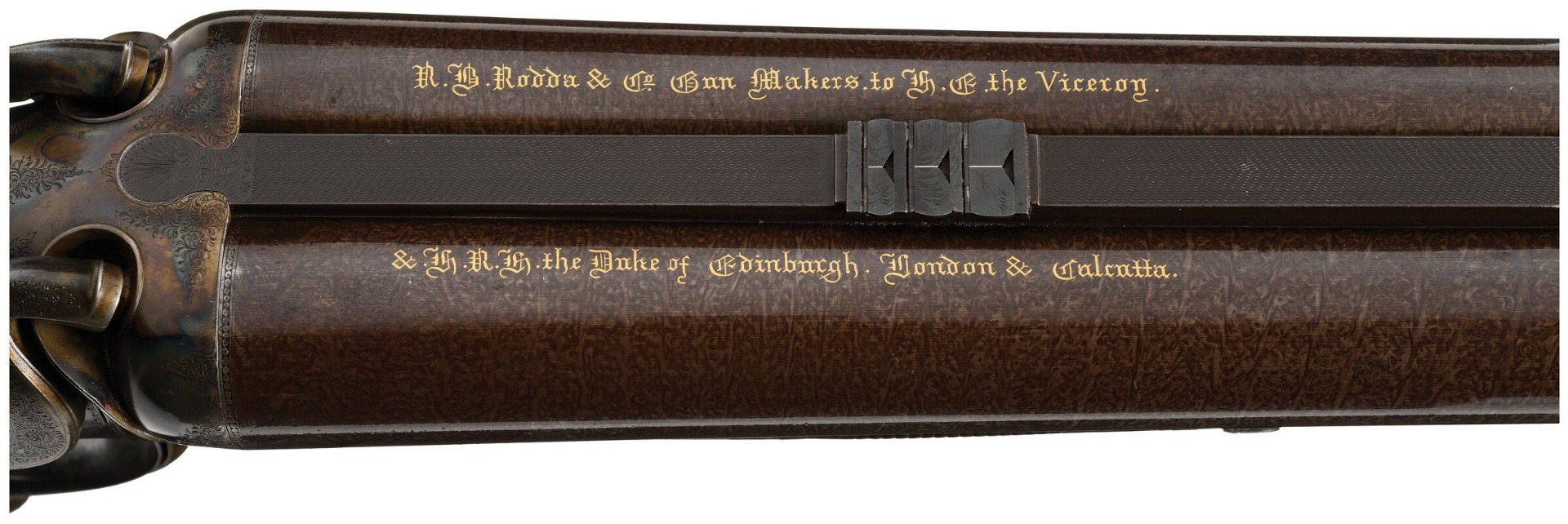
On the barrels of this rifle are the gold inlaid inscription common to R.B. Rodda guns: on the left barrel “R.B. Rodda & Co Gun Makers to H.G. the Viceroy.” and on the right “& H.R.H. the Duke of Edinburgh. London & Calcutta”, indicating that Rodda guns were guns of the nobility.

British guns of this era had to be not only of the best quality but also of most intelligent design. Because of the wide experience British gunmakers obtained because of the extent of the British Empire they developed expertise that few others could match.
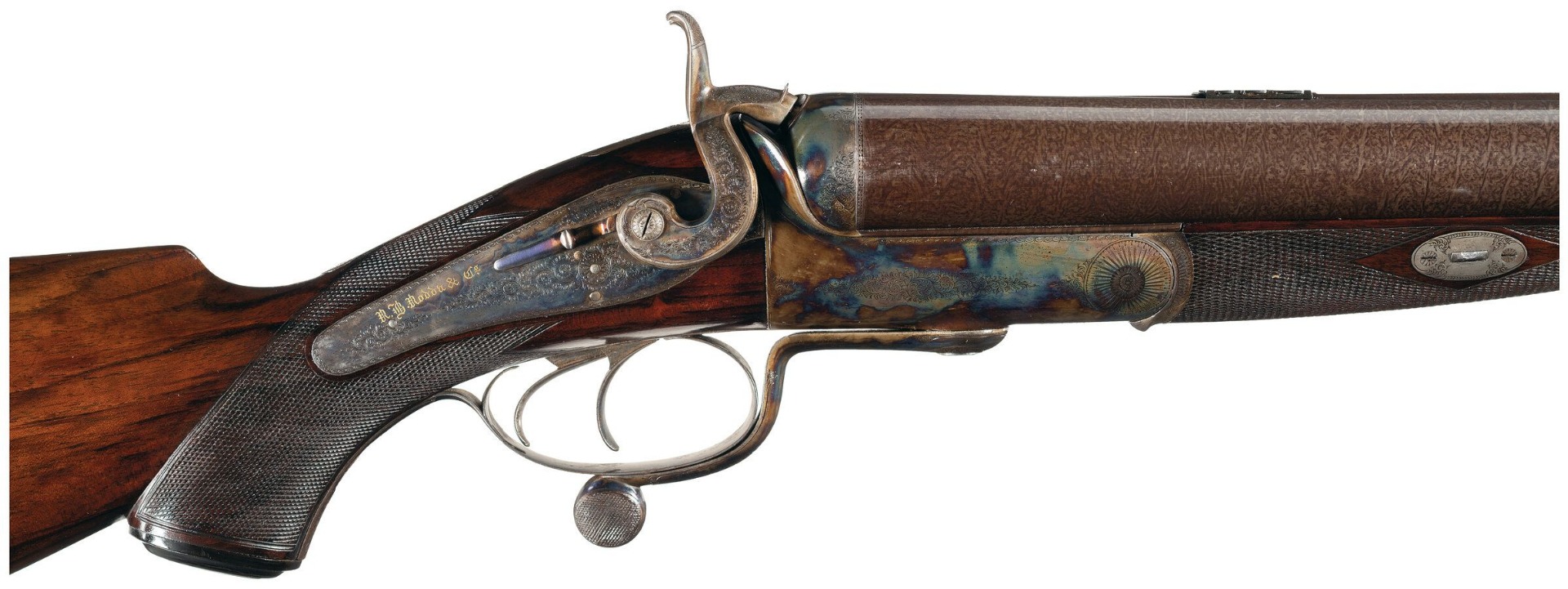
This 4 bore rifle is of typical dimensions to others of its calibre: length of pull is 14¼”, while the weight is a sensible 20lb 13oz – so almost 21lb.
The weight and carefully designed stock and overall rifle proportions made this rifle as easy to manage as one of this heft can be.
It was loaded with a spherical ball backed with 9 drams of Curtis & Harvey’s No. 6 black powder.

This Rodda 4 bore rifle is also coming up for sale at Rock Island Auction’s coming Premier Firearms Auction to be held between August 26th-28th, 2022.
To find out more you can visit the listing here.
These two rifles are representative of the best of the dangerous game rifles of the nineteenth century, one more typical of Africa, the other of “the Jewel of the British Empire” India.
(All pictures of the sale rifles courtesy Rock Island Auction.)

Jon Branch is the founder and senior editor of Revivaler and has written a significant number of articles for various publications including official Buying Guides for eBay, classic car articles for Hagerty, magazine articles for both the Australian Shooters Journal and the Australian Shooter, and he’s a long time contributor to Silodrome.
Jon has done radio, television, magazine and newspaper interviews on various issues, and has traveled extensively, having lived in Britain, Australia, China and Hong Kong. His travels have taken him to Indonesia, Israel, Italy, Japan and a number of other countries. He has studied the Japanese sword arts and has a long history of involvement in the shooting sports, which has included authoring submissions to government on various firearms related issues and assisting in the design and establishment of shooting ranges.

